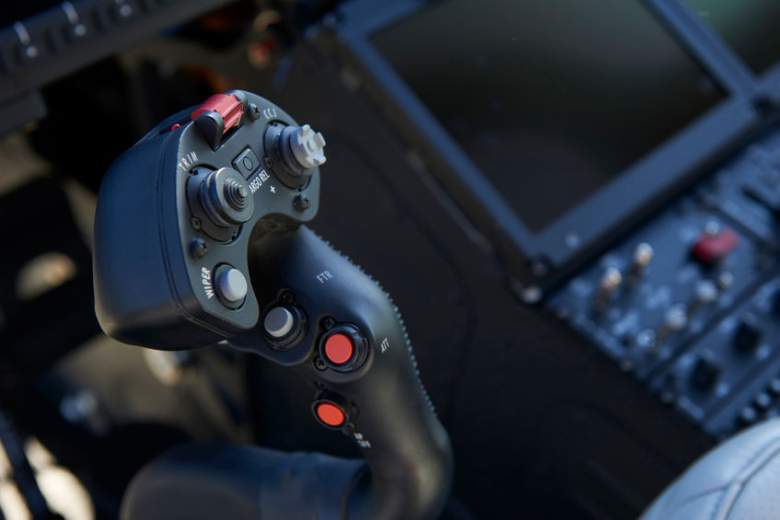
There was a time, it seemed when joysticks were absolutely essential gaming gear for every PC gamer. In those days, there was an abundance of flight simulators, space shooters, and other action games that demanded keeping a joystick on your desktop. Times have changed — there aren’t nearly as many of those kinds of games anymore. But they’re still around — just in short supply. If you’ve been bitten by the slight sim bug with the release of Microsoft Flight Simulator or want to try your hand at VR space combat in Star Wars: Squadrons, you might find that flight sticks are hard to find and much more costly than they should be.
Whether you are a hardcore sim fanatic who wants to accurately model the cockpit of a modern fighter jet or someone with a more casual approach to flying, it’s hard to enjoy a space – or air-based game with a mouse and keyboard in the same way that an MMO player needs a specialized gaming mouse to realize their full potential as well. But which joystick is right for you? To make your decision a little easier, I have rounded up the best flight sticks and joysticks that you should be able to actually get your hands on right now. After looking at each one, check out the end of this article, where I recommend which one you should choose depending upon what kind of gamer you are, and suggest how to choose the right flight stick if you’re shopping for yourself.
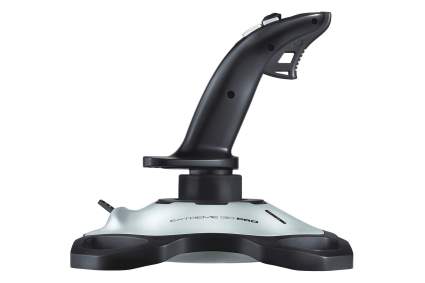
|
Amazon Customer Reviews
|
Price: $33.49 Shop at Amazon | Shop now Read our review |
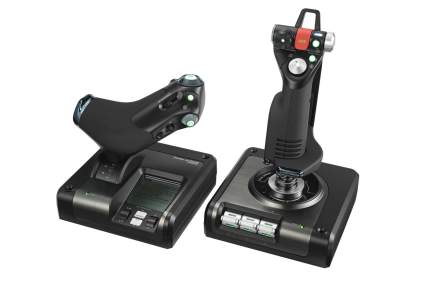
|
Amazon Customer Reviews
|
Price: $318.53 Shop at Amazon | Shop now Read our review |
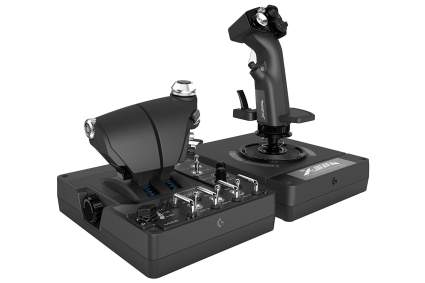
|
Amazon Customer Reviews
|
Price: $329.99 Shop at Amazon | Shop now Read our review |
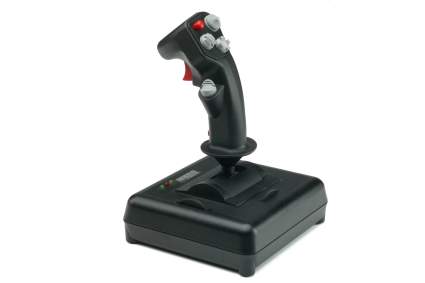
|
Amazon Customer Reviews
|
Price: $93.95 Shop at Amazon | Shop now Read our review |
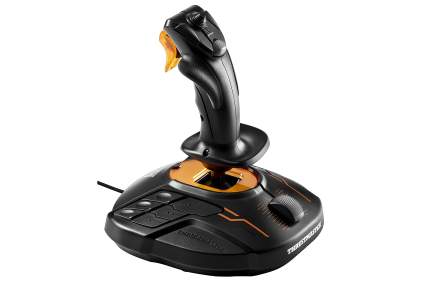
|
Amazon Customer Reviews
|
Price: $79.99 Shop at Amazon | Shop now Read our review |
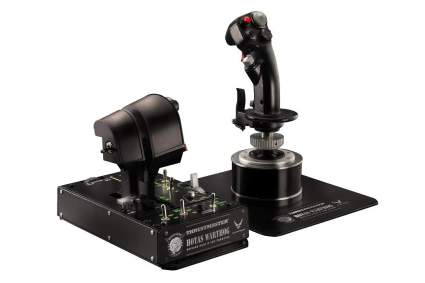
|
Amazon Customer Reviews
|
Price: $878.00 Shop at Amazon | Shop now Read our review |
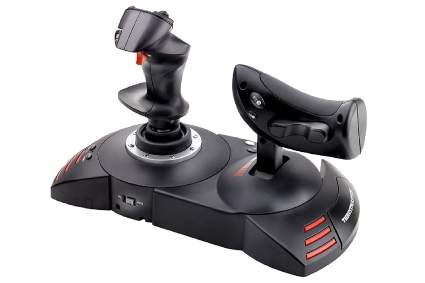
|
Amazon Customer Reviews
|
Price: $159.00 Shop at Amazon | Shop now Read our review |
-
1. Logitech Extreme 3D Pro
Pros:- Low price
- Z-axis and throttle lever
- Simple to operate
Cons:- A little play in the stick sensitivity
- No lighting
- Limited number of programmable buttons
Weight: 2.5 pounds | Dimensions: 9.2 x 8.8 x 8.4 inches | Total controls: 12 | Lighting: No | Joystick type: Stick | Connection: USB
Like most joysticks on the market in 2020, the Logitech Extreme 3D Pro has been around for years — this one dates back to the mid-2000s, but is still beloved enough that it’s available for sale this many years later. It’s unabashedly a low-cost, entry-level joystick. Made entirely from plastic and quite lightweight, it feels like a toy yet is still up to the task of playing modern sims and games.
It mostly stays put not using suction cups, but thanks to grippy rubberized pads on the bottom of the base. Logitech describes the base as weighted, but let’s be honest: At just over 2 pounds, that weighted base isn’t going to stop any sliding around. But the rubberized pads are actually is a pretty good solution for most surfaces, though there may be some desktops that the joystick tends to slide around on, so your mileage may vary. It’s also worth noting that the base is quite large. Over eight inches square, you may need to make sure your desk surface can accommodate it.
Obviously, this is a single stick design, with and includes four axes of motion, including a handy Z-axis twist for rudder control and a small but effective lever, usually intended for throttle. In addition, the joystick includes a total of 12 buttons and a single hat. All the buttons are configurable for your needs in whatever game you’re playing. The stick itself has a nice feel and naturally “nulls” back to its center position, though there is a bit of “play” in the movement that affects precision. It’s not bad, and something you need to accept in a joystick in this price range.
Looking for headphones to go with your joystick? Check out our roundup of wireless gaming headsets for the PC. And if you have a drone, be sure to check out our recommendation for the best drone cases for travel and storage.
Find more Logitech Extreme 3D Pro information and reviews here.
-
2. Logitech G X52 Pro Flight Control System
Pros:- Multi-function LCD display
- HOTAS with optional foot pedal
- 105 programmable buttons
Cons:- Extremely lightweight
- Appearance is mixed bag
- No dual throttle
Weight: 2.3 pounds | Dimensions: 10.9 x 6.7 x 6.7 inches | Total controls: 105 | Lighting: Yes | Joystick type: HOTAS | Connection: USB
Logitech owes the X-52 to Saitek, the iconic PC joystick company that originally released the X-52 before Logitech acquired the company and rebranded the flight stick under its own name. The X-52 has been around, more or less unchanged, for a very long time now, but that’s not really a bad thing. It’s a superb mid-priced joystick with a lot of features for someone who wants an authentic simulator experience.
Visually, this joystick combo is a mixed bag. First, the good: It’s a two-piece HOTAS-style stick and throttle, and it has a solid number of buttons and hats, which suggests a lot of potential for programmability and authenticity. Perhaps best of all, the throttle includes a multifunction LED display that looks amazing and has practical applications. But there’s a lot of plastic here, with some ugly seams that ruin your sense of immersion, as well as a brushed aluminum top plate that makes the whole thing look a little dated. And the whole thing is light. Very light. You’ll need to use the action cups, and even then it has a tendency to drift around on your desk in the heat of combat.
The X-52 gives you a lot of configurability. With 19 buttons, 3 hats, and 7 axes for up to 105 customized actions, you’re not likely to grow out of this joystick soon — though if you go all-in with the right games, it’s not out of the question that you’ll bump into frustrating limitations. But some touches are cool, like the way that the main trigger has two modes of fire depending upon how far back you pull. A light touch might fire guns, while a full depress could launch a missile.
As I mentioned, the LED display on the throttle isn’t just to look pretty; you can use it to get information about your button configuration or other profile data, as well as to run a flight plan clock or stopwatch. And the various stick components are highly configurable; you can dial in the resistance you want from your joystick, and if you don’t want to use the stick’s Z-axis for rudder control, you can disable it and add an optional foot pedal.
-
3. Logitech G X-56 H.O.T.A.S. RGB Throttle and Stick
Pros:- HOTAS with twin throttle
- 189 programmable buttons
- RGB lighting
Cons:- Lightweight, needs suction to hold down
- Consumes two USB ports
- Inherits some quality control issues from X-55
Weight: 5 pounds | Dimensions: 11.4 x 6.7 x 7.1 inches | Total controls: 49 | Lighting: Yes | Joystick type: HOTAS | Connection: 2 USB ports
Logitech’s X-56 throttle and stick combo borrows heavily from the venerable Saitek X-55, a long-time favorite among die-hard flight sim gamers (despite infamously being plagued by a number of well-known quality control issues, some of which continue to appear in the X-56). The X-56 is a HOTAS configuration, with separate joystick and throttle units which can be widely separated, such as on opposite ends of your keyboard. The construction is solid, though Logitech built it mainly out of plastic, with a metal top plate for rigidity. In the end, that means it’s on the light side. To keep it from sliding around on your desk, the bottom has suction cups.
There are a lot of customizable controls. The stick combo has 30 buttons, 5 hats, and 13 movement axes, all of which are completely programmable using Logitech’s desktop software. That’s a total of 189 programmable controls, which is likely more than you’ll ever need. Even so, it can radically transform your sim experience — after binding important tasks to buttons, you can play your favorite flight sims by feel alone, with your hands never leaving the stick and throttle.
Logitech didn’t model the X-56 after any particular kind of aircraft, which means the many controls are generic enough that they apply to any simulated vehicle under the sun. In point of fact, Logitech biased the design to favor space sims, and it’s joyous to pair with a game like Elite: Dangerous. And regardless, the independent twin throttle lets you control twin-engine vehicles with ease.
The stick is also fully equipped with RGB lighting, and you can set the color for virtually every control and surface separately. It’s not just for aesthetics; that can help you find important controls quickly and easily in the heat of gameplay.
-
4. 200-571 CH Products Fighterstick USB
Pros:- Solid and rugged
- Four hat controls
- Compatible with pedals
Cons:- Few push-button controls
- Antiquated design
- No Hall Effect calibration
Weight: 0.6 pounds | Dimensions: 10.6 x 9.2 x 7.7 | Total controls: 24 | Lighting: No | Joystick type: Stick | Connection: USB
CH Products is an iconic name in flight sticks, and the overall look and feel of the company’s products hasn’t changed in decades — whether that’s a good thing sort bad is a matter of opinion. This much is true: Don’t expect a lot of innovation from a joystick like the CH Products Fighterstick USB. The list of things it does not have is extensive. There’s no Z-axis control, for example, nor is there Hall Effect magnetic calibration, lighting, or metal construction. As for weight, in fact, this joystick is pretty light — under a pound — and relies on suction cups to hold it in place.
The reason that some gamers continue to return to CH Products joysticks like the 200-571 is rock-solid construction and extreme longevity — the lack of the Z-axis control, for example, means the pots used to control the joystick can be more accurate without resorting to Hall Effect sensors, and the overall stick can stand up to gaming abuse for years. I’ve heard of people using the same stick for 15 years — that’s impressive.
The 200-571 is a very minimal design. While CH Products claims 24 buttons, only three are actual push buttons, and none of them are two-mode controls. Instead, the majority of the stick’s controls are hats: You get three 4-way hats and one 8-way hat. So, if you like hats, this is your joystick.
Find more 200-571 CH Products Fighterstick information and reviews here.
-
5. Thrustmaster T16000M FCS
Pros:- Hall Effect stick calibration
- Ambidextrous design
- Touch-friendly buttons
Cons:- Light weight
- Convoluted desktop software
- No lighting
Weight: 2.6 pounds | Dimensions: 9.6 x 8.3 x 8 inches | Total controls: 16 | Lighting: No | Joystick type: Stick | Connection: USB
Thrustmaster’s T.16000M FCS joystick is a surprising gem in the world of lower-cost joysticks that surprises you at every turn. First of all, it’s a solidly built rig. Every button and lever has a reassuring feel, and even though the whole contraption is made from plastic — it definitely has that undeniable “toy” vibe when positioned next to something like the all-metal Thrustmaster HOTAS Warthog — it feels solid in your hand.
You get four axes of control — the stick has a rudder-friendly Z-axis twist and there’s a throttle lever on the base — along with 16 buttons and a hat. While it doesn’t add a sense of authenticity to the joystick, it’s hard not to love the buttons. Thrustmaster added “Braille” style dots and divots to the controls, making them easier to find by feel in the heat of battle. It’s a small, thoughtful though that more joysticks should take to heart.
The stick itself is unusual for a product in this price range. It uses magnetic sensors (which rely on something called the Hall Effect) for calibration to ensure that the stick’s accuracy will never drift within a gaming session or even over its lifetime. This is the same tech you’ll find in pricey joysticks but is a rare find indeed in a stick under $100.
And that’s not all. The T.16000M has another thoughtful trick up its sleeve: It’s 100% ambidextrous. It takes just a few moments to reconfigure the stick for identical left- or right-handed operation, which makes this one of the few joysticks you can unambiguously recommend for lefties.
If you ever want to step up from a single stick to a more expansive HOTAS configuration, you don’t need to lose your investment in the T.16000M — Thrustmaster sells accessory throttle and pedals, so you can expand this into a complete system.
Find more Thrustmaster T16000M FCS information and reviews here.
-
6. Thrustmaster HOTAS Warthog
Pros:- Extremely authentic, high quality design
- Anchors in place with heavy design
- Highly configurable
Cons:- No Z-axis for rudder control
- QUite expensive
- Software can be challenging to learn
Weight: 14 pounds | Dimensions: 18.1 x 9.8 x 12.6 inches | Total controls: 57 | Lighting: Yes | Joystick type: HOTAS | Connection: 2 USB
Let’s get this out of the way right up front: The Thrustmaster HOTAS Warthog is more or less the pinnacle of the flight stick business. Short of tearing hardware out of a real fighter jet, Thrustmaster’s joystick and throttle combo is as good as it gets. As authentic as it gets. And pretty much as expensive as it gets. But for a certain kind of gamer, it’s worth it. That said, flight stick shortages have driven the price of this model to insane levels. Unless you have a weekday Tesla and a weekend Tesla, there’s probably no way to justify paying the current price for this flight stick. That said, let’s take a look at it.
The Warthog gets its name from the fact that this isn’t a generic joystick; it’s modeled, as accurately as possible, after the flight controls in the cockpit of a real A-10 Warthog. To that end, it’s a split HOTAS controller with accurately modeled buttons, hats, and axes of control based on unclassified plans from the A-10. This is great if you’re a stickler for accuracy, and of course, everything on the stick is remappable and reprogrammable, so you can make it work with pretty much flight sim. But this attention to authenticity gives rise to one frustrating limitation you won’t encounter with many lower-end joysticks: Because A-1o pilots can’t twist the joystick to actuate the rudder, you can’t either. The Thrustmaster doesn’t support Z-axis control. Bummer.
It’s also the heaviest joystick you’ll probably ever have the joy to use. Clocking in at over 13 pounds for the two controllers, they’re mostly made of metal with enormous metal baseplates to keep them from sliding around (you can even bolt them down if you’re so inclined — they have mounting holes).
The whole rig is made with care and for the long haul. The joystick itself is replaceable (and hefty on its own, weighing more than 2 pounds). Thrustmaster didn’t simply pack this controller with buttons and hats; the 57 or so controls precisely match the real-world equivalent controls in a real USAF aircraft, and they are completely remappable via the desktop software. There are even a handful of programmable lights as well. Of course, you don’t need to program it yourself, since you can download optimized profiles from the Thrustmaster web site for most popular games and sims. And your rig can grow with you. There are compatible accessories including foot pedals and a multifunction display modeled after the one in the F-16.
Find more Thrustmaster HOTAS Warthog information and reviews here.
-
7. Thrustmaster T.Flight HOTAS X
Pros:- Good price
- Decent amount of programmability
- Throttle and stick can work connected or separated
Cons:- Plastic feels cheap
- Has the aesthetics of a toy
- Not as accurate as higher-end joysticks
Weight: 4.7 pounds | Dimensions: 7.5 x 5.3 x 1.2 inches | Total controls: 12 | Lighting: No | Joystick type: HOTAS | Connection: USB
Thrustmaster has a reputation for really caring about the joysticks it makes. No matter whether you’re using the Thrustmaster HOTAS Warthog — which costs as much as an inexpensive laptop — or the Thrustmaster T.Flight HOTAS X, which usually costs under $100 (except in these trying times when all flight sticks are in desperately short supply), it’s clear that the company doesn’t take needless shortcuts or slap together a shoddy product. I point that out because the T.Flight is an inexpensive joystick, but it punches well above its weight class and can make you relatively happy (at least for a while) if you’re exploring serious slight or space sims.
It does look a little cheap. The T.Flight is all plastic, with a gaudy molded plastic base, and it’s all hard plastic, with no rubberized or metal parts. But it’s still a solid performer. Thrustmaster thought to weight the base, for example, to make it a little more stable, though it’s still fairly light. It’s a HOTAS combo, but the throttle and joystick are connected into a single unit by default. They’re super easy to separate as well, so you can place the stick and throttle on either side of your keyboard. Between the two components, you get 12 buttons and hats as well as 5 axis of motion, all of which are completely programmable. You can use the desktop software to create multiple profiles, and there’s internal memory in the joystick to store all the settings — that way you can take the joystick to another PC and not lose your button programming and other profile settings.
Of course, keep in mind that this isn’t a hyper-accurate $200 (or more) joystick. The stick itself feels sloppy within your grasp, with a wobbly dead zone and a somewhat mushy, sluggish feel. Is that a show stopper? Not at all. In fact, you probably won’t even mind all that much unless you have a higher caliber stick to compare it against.
Find more Thrustmaster T-Flight HOTAS X information and reviews here.
Common Flight Stick Terms
There are a few common terms that joystick manufacturers throw around. If you're shopping for a joystick for the first time, here's a guide to the ones you most need to know:
Hall Effect sensors are magnets that are used to keep a joystick accurately calibrated at all times. It's a highly effective way to ensure the positioning quality of a joystick at all times. Joysticks without Hall Effect sensors tend to degrade in quality over time, both within a single gaming session and over time.
A hat -- short for hat switch -- is a control that slides or rocks in different directions rather than depressing in. A 4-way hat, for example, moves up, down, left, and right, and each position can activate a different command. There are also 8-way hat switches. Hat switches are generally used to change views or activate menu selections, but as with most controls on joysticks, are usually fully programmable.
HOTAS stands for Hands on Throttle ands Stick, and usually takes the form of separate joysticks and throttle controls you can operate with both hands.
Z-axis refers to the axis that comes up vertically out of the stick (remember your X, Y, and Z axes from high school geometry). Most -- but not all -- joysticks let you twist the stick around the Z-axis, which is a handy way to control the rudder. If a joystick lacks a Z-axis twist, you'll need to control the rudder a different way, which often feels less realistic or is simply inconvenient. The irony, of course, is that real aircraft don't control their rudders using a twisting stick; pilots control the rudder with foot pedals.
How to Shop for a PC Joystick
Joysticks vary greatly in terms of features, complexity, and price, so it's helpful to know what you need before you get too deep in the weeds comparing different joysticks.
First, decide what general class of joystick you need -- they can range from well under $100 to $400 or more, and the higher-end sticks tend to lean hard into giving gamers a sense of authenticity and immersion, as if you're flying something real. Pricier joysticks tend to be heavier and more stable on the desk, often made with a lot of metal components. If the stick is lighter, it'll need rubberized pads or suction cups to stay in one place.
The number of programmable buttons might initially seem like a big deal, but for most gamers, even a dozen buttons is generally enough. Keeping track of 50 or 100 customized buttons is not easy, and you'll need to be a dedicated Elite: Dangerous or Microsoft Flight Simulator fanatic to make the effort. The bottom line: The sheer number of buttons is probably not especially important. Something that does affect gameplay, though, is how easily those buttons can be remapped, and whether it's possible to download profiles with those buttons preconfigured for specific games.
Do you want a single stick, or are you interested in a HOTAS system? Standing for "hands on throttle and stick," a HOTAS combo is the fastest way to amp up the realism in a simulator. It's also convenient and fun. A HOTAS config usually includes two separate units -- one with the joystick and a second with the throttle. Some throttles go the extra mile by splitting, letting you control two engines at once much like in a real cockpit.
A joystick is a mechanical system, so you might also want to consider the actual mechanics. Some joysticks are stiffer or springier than others, while buttons and hats have their own feel as well. You might also consider it important for some buttons -- especially the trigger -- to have two positions, so you can activate different weapons based on how hard you squeeze.
The Best Value in PC Joysticks: Which One Should You Choose?
The sad reality is that with interest in flight and space simulators at an all-time low, there hasn't been a lot of interest among manufacturers to create a lot of joystick options or to actively refresh their product line. But that's okay; there are still great choices for every kind of gamer, and there are some great choices out there if you want to dive into the new Microsoft Flight Simulator.
If price is pretty much no object and you want the best, most authentic flight simulator experience available, look no further than the Logitech G X-56. Not only will it make you feel like a real pilot, but the programmability and huge array of buttons is ideal for a game like Elite: Dangerous, not to mention Flight Simulator. It edges out the Thrustmaster HOTAS Warthog because the Warthog lacks a Z-axis twist.
At the other end of the spectrum, the best value in an affordable joystick is the Thrustmaster T16000M FCS, a great stick that has Hall Effect calibration, well-marked buttons, and can even be quickly and easily configured for left- or right-hand use.